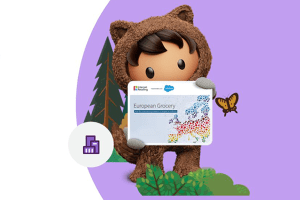The past year has been a transformative one for UK grocery retailers and their customers, as not only did new ways of shopping emerge in the wake of COVID-19 – so did new concerns. Almost overnight, shoppers had to adapt to lockdown measures, social distancing and stock shortages, and they had to do it while facing ever-shifting health and safety guidelines.
For grocery retailers across Europe, the crisis presented an extraordinary challenge – but it also presented a golden opportunity to innovate and develop new products and services. Some faltered, others thrived, but one thing’s for sure – there’s no going back to the old world.
To find out how grocery retailers navigated the pandemic and where they’re headed next, Internet Retailing and Salesforce conducted surveys and interviews with grocery retail executives, and FMCG and CP brands from across Europe. The findings have now been published in the report, European Grocery: How the coronavirus pandemic reshaped an industry. Let’s have a closer look at the report and see what it reveals about the priorities of grocery retailers in 2021 and beyond.
Top insights from the report
Consumers are focusing on wellness and sustainability and grocery retailers are following suit
Consumers had already begun making healthier, more sustainable choices prior to the pandemic, but that behaviour was accelerated by COVID-19. Many grocery retailers responded by developing their own lines of heath-centric products and delisting products that were becoming irrelevant in the changing climate. Online grocery retailer Picnic launched an own-label line of organic foods, while Carrefour partnered with small, sustainable brands to sell healthy products at a local level.
- According to a survey conducted by Kantar, 52% of consumers say that they’re paying more attention to the origin of products, and nearly 70% say that they’re supporting local shops.
Sustainability concerns are coming into sharper focus in this new climate of responsible consumerism, and health-conscious, socially conscious lines that promote wellbeing will continue to flourish.
The pandemic opened up the digital gates and there’s no turning back
There was a massive shift to online shopping in the UK, as the channel now accounts for 13% of all grocery-shopping sales – up from just 7.4% in March. In fact, one in five UK households now buy groceries online, and this is only expected to grow. Q4 of 2020 saw a huge rise in web traffic over the same quarter in 2019, and this massive digital growth is fuelling optimism amongst grocery retailers, with 77% saying that they expect their business to outperform the sector in 2021.
This embrace of online shopping should be considered ‘the new normal’, and grocery retailers are focusing on artificial intelligence, highly personalised engagement and innovative technologies to grow stronger and more resilient in the face of change.
- Nearly half of respondents (47%) say that the digital experience is a bigger priority for them over the next 12 months.
The report also reveals just how important data is becoming in the new climate, with 29% of executives in the industry saying that data has become a bigger priority for the upcoming year. The shift towards digital has provided the grocery industry with a wealth of valuable new product and purchasing data, which can be leveraged to create loyalty programmes, formulate effective D2C strategies and better understand customer lifestyles. “We are using Facebook and Instagram to get feedback from consumers about new recipes and what people would like to buy. In a way, this is becoming a bit like the new customer marketing insight department,” says Hervé Beck, general manager of France Benelux & EMEA, Kind.
Here’s how Tesco pivoted to meet demand
In order to cope with increased demand and provide expedient service in the face of lockdown measures, Tesco installed an automated micro-fulfilment centre in one of their London stores. By combining automation with human workers, Tesco was able to fulfil 3x as many orders, with orders being ready in mere minutes rather than hours. “The flexibility of having a mix of manual, human-powered activity and automation has helped us grow capacity in a way that would have been difficult had we purely had an automated platform,” says Chris Poad, managing director, online, Tesco. These automated, micro-fulfilment towers are expected to be a larger part of Tesco’s platform going forward, enabling them to create new services and better respond to customers’ demand for immediacy and convenience.
In addition to these micro-fulfilment centres, Tesco hired 16,000 more staff, purchased fleets of delivery vans and extended collection hours. They made 50 large operational changes and hundreds of smaller ones, and the efforts paid off: Between March and the end of June, Tesco was able to double its online capacity – fulfilling 1.5 million orders per week for delivery or click-and-collect.
What’s next for the UK grocery industry?
Executives in the grocery industry have faced challenges and adapted to grow stronger over the past year. In pressure, they’ve found utility, and the report portrays a landscape that’s rich with promise. Nearly three-quarters of grocery executives across Europe (74%) say that the pandemic has made their role more positive and important to their business; 84% say that the grocery and food sector will grow substantially over the coming year; and 64% say that they’re leaping ahead of competitors due to their performance during the pandemic.
To read the full report, European Grocery: How the coronavirus pandemic reshaped an industry, visit us here.

























